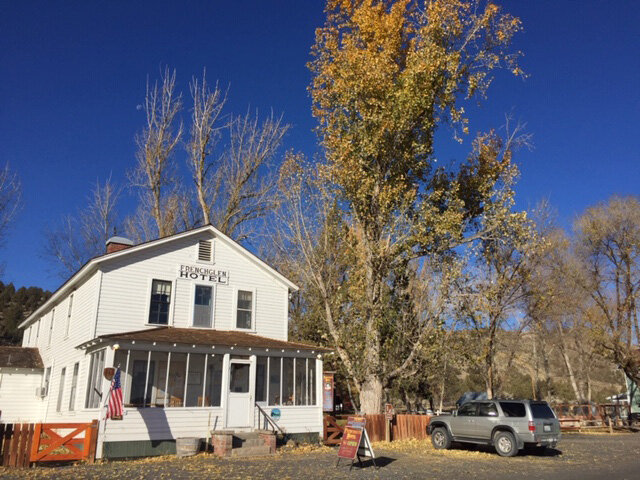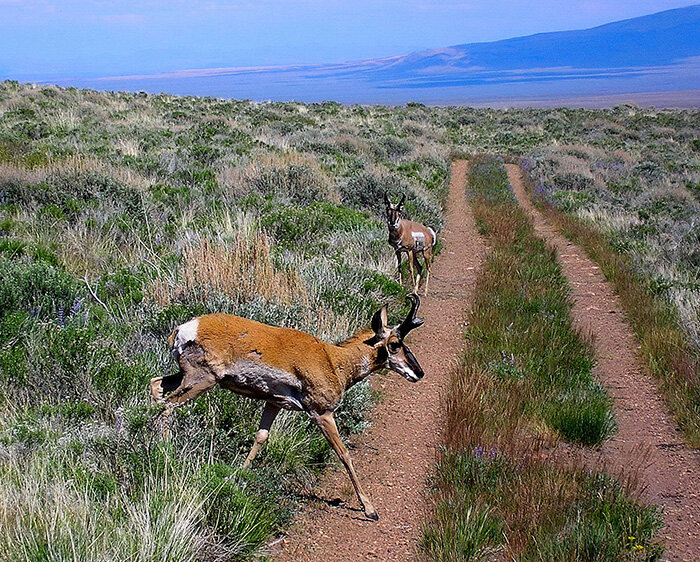
I’m a middle-age white guy in a 1999 4Runner, V6, 206 cubic inches, 4WD, steel-belted Michelin truck tires.
He’s a pronghorn buck, 2016 vintage, 206 pounds, 4-leg drive, keratin tires.
Who’s gonna win?
No contest. And not just because the back roads on Hart Mountain National Antelope Refuge are really sketchy (they are) but also because the pronghorn antelope is the fastest land animal in North America. He could still beat me on a well-maintained gravel county road, inasmuch as antelope can reach 50 mph in short bursts.
 The Frenchglen Hotel.
The Frenchglen Hotel.I’ve come here in two long bursts from the Salish Sea. Eight hours drive, a stop in Pendleton, then 6 more hours to Hart, and I’m in a place so radically different from my island home that it’s another universe. This is my favorite Northwest road trip. Contrast is good for the soul. Uniformity is life’s fast food; come to Steens Country and there’s no fast food for hundreds of miles. Instead, there are pronghorn/car drag races.
Of course, the buck isn’t on a road. I am, bucking along a pavement made of desert dust, sagebrush roots and basalt. He’s dashing through the sage about 20 yards away, clearly enjoying our race across Guano Flats at the far southern end of the refuge.
Why are we racing? Biologists believe pronghorns like to match their speed against cars for, well, fun. And why not? We can’t catch them. Nobody can, really. Hart Mountain’s healthy cougar population focuses on deer and bighorn sheep, and the few hunters who prowl the refuge in the fall do best from blinds. But race-car pronghorns are just the start of innumerable non-Pacific things one can see and do around this part of southeastern Oregon.
“The Steens,” as locals and fans call the area, is anchored by Hart Mountain’s 8,017-foot fault-block monolith, and Steens Mountain itself 60 miles away, a 9,733-foot behemoth that is by far the biggest thing for hundreds of miles. The entire region is larger than many European countries, but has less than 15,000 residents. Drive to the top of Steens – the highest auto road in the Northwest – and as you step over mid-July snowdrift remnants, you can gawk straight down almost 6,000 feet to the flat salt plain of the Alvord Desert. Once you’re done gawking, you could also:
 • Stop to admire the mountain’s 300-strong wild horse herd. Desert advocates grouse that these are “feral” (non-native invasive) animals; and so they are, descendants of late 19th century ranch and cavalry cavvies, but beautiful and inspiring nonetheless.
• Stop to admire the mountain’s 300-strong wild horse herd. Desert advocates grouse that these are “feral” (non-native invasive) animals; and so they are, descendants of late 19th century ranch and cavalry cavvies, but beautiful and inspiring nonetheless.
• Watch the roadsides carefully for badgers, rattlesnakes, mule deer and golden eagles perched on fence posts like emperors.
• Hike three miles up Big Indian Creek to a high meadow where the area’s Paiute inhabitants used to bring horses to race during summer high-country camps.
• Get stuck behind a cattle drive on the East Steens Road, which parallels the Alvord Desert at the foot of its namesake mountain. When you finally can pass, the cowgirl lifts her broad-brim hat in greeting.
• Pull off to soak in the blissful, 108-degree mineral-rich waters of Alvord Hot Springs, where the view itself is larger than Liechtenstein.
• Cast a Woollybugger fly into tiny pools in mountain streams for the rare and beautiful red-band rainbow or Lahontan cutthroat trout, both uniquely adapted to the harsh desert environment.
• Make camp amid shimmering aspens at Hart Mountain, setting a couple of trout to cook over a spicy juniper fire. Later, lie awake listening to nighthawks dive in the dusk.
• Or pull into the Frenchglen Hotel at 6 p.m., because it’s the only lodging for miles and miles, and the hotel’s ranch supper is “promptly served” at 6:30 p.m. sharp and laggards lose out. Maybe, if you’re late, there’ll be some peach cobbler left. Maybe not.
 Oregon tourism officials label the state’s dry eastern side the Oregon Outback. I favor Ian Tyson’s description, the Sagebrush Sea. Frenchglen, the “town” in the center of the Steens, consists of eight buildings, one street, one store and one restaurant, with oceans of sage and juniper in every direction, interrupted by cottonwood armies along a mountain-born river named Donner & Blitzen (“thunder and lightning” in German). Here, in the riverside lowlands watered by the Steens summit snowmelt, enough lush grass grows that 150 years ago an enterprising cattleman named Pete French established the largest ranch in the country, the P Ranch. Though the town is named for him, his more famous legacy is as the cattle baron gunned down by a homesteader in 1897. Yes, just like in the movies.
Oregon tourism officials label the state’s dry eastern side the Oregon Outback. I favor Ian Tyson’s description, the Sagebrush Sea. Frenchglen, the “town” in the center of the Steens, consists of eight buildings, one street, one store and one restaurant, with oceans of sage and juniper in every direction, interrupted by cottonwood armies along a mountain-born river named Donner & Blitzen (“thunder and lightning” in German). Here, in the riverside lowlands watered by the Steens summit snowmelt, enough lush grass grows that 150 years ago an enterprising cattleman named Pete French established the largest ranch in the country, the P Ranch. Though the town is named for him, his more famous legacy is as the cattle baron gunned down by a homesteader in 1897. Yes, just like in the movies.
Today’s cattle barons run smaller ranges, and coexist largely in peace with the 21st century pilgrims who come here to bird-watch, hike, sightsee and breathe sage air that I believe is an antidote to everything from modern malaise to Covid.
I can’t prove that, but I’ve been here almost every year since Bill Clinton was president. Native Americans burn sage to banish evil spirits; each year I bring some back from the Steens and in my home the desert’s sharp scent easily bridges the 500 miles between my island farm and the Sagebrush Sea.
And eventually, each year, the pronghorn pacing my car pull up and remind me that life’s not really a race. I get out, listen to the quiet, breathe in the sage, and salute their good common sense. x
Eric Lucas is the author of the Michelin guide to Alaska. He lives on a small farm on San Juan Island, where he grows organic hay, garlic, apples and beans.